Modeling the effects of cross immunity and control measures on competitive dynamics of SARS-CoV-2 variants in the USA, UK, and Brazil
IF 1.8
4区 数学
Q2 BIOLOGY
引用次数: 0
Abstract
Mutation in the SARS-CoV-2 virus may lead to the evolution of new variants. The dynamics of these variants varied among countries. Identification of the governing factors responsible for distinctions in their dynamics is important for preparedness against future severe variants. This study investigates the impact of cross immunity and control measures on the competition dynamics of the Alpha, Gamma, Delta, and Omicron variants. The following questions are addressed using an n-strain deterministic model: (i) Why do a few variants fail to cause a wave even after winning the competition? (ii) In what scenarios a new variant cannot replace the previous one? The model is fitted and cross-validated with the data of COVID-19 and its variants for the USA, UK, and Brazil. The model analysis highlights implementations of the following measures against any deadlier future variant: (i) an effective population-wide cross-immunity from less lethal strains and (ii) strain-specific vaccines targeting the novel variant. The system exhibits a fascinating dynamical behavior known as an endemic bubble due to Hopf bifurcation. It is observed that the actual situation in which Omicron won the competition from Delta followed by no wave due to Delta may turn into a competitive periodic coexistence of two strains due to substantial disparity in fading rates of cross-immunity. Global sensitivity analysis is conducted to quantify uncertainties of model parameters. It is found that examining the impact of cross-immunity is as crucial as vaccination.
模拟美国、英国和巴西的交叉免疫和控制措施对SARS-CoV-2变异体竞争动态的影响
SARS-CoV-2病毒的突变可能导致新变体的进化。这些变异的动态因国家而异。识别导致其动态差异的控制因素对于防范未来严重变异的准备是重要的。本研究探讨了交叉免疫和控制措施对α、Gamma、Delta和Omicron变体竞争动态的影响。使用n-应变确定性模型解决以下问题:(i)为什么少数变体即使在赢得比赛后也未能引起波动?在什么情况下新的变型不能取代以前的变型?该模型与美国、英国和巴西的COVID-19及其变体数据进行拟合和交叉验证。模型分析强调了针对任何更致命的未来变种的以下措施的实施:(i)针对较低致命性菌株的有效的全人群交叉免疫和(ii)针对新变种的菌株特异性疫苗。由于Hopf分岔,该系统表现出一种令人着迷的动力学行为,称为地方性气泡。观察到,由于交叉免疫衰减率的巨大差异,Omicron从Delta的竞争中获胜后因Delta而无波的实际情况可能会转变为两株的周期性竞争共存。通过全局敏感性分析,量化模型参数的不确定性。研究发现,检查交叉免疫的影响与接种疫苗一样重要。
本文章由计算机程序翻译,如有差异,请以英文原文为准。
求助全文
约1分钟内获得全文
求助全文
来源期刊

Mathematical Biosciences
生物-生物学
CiteScore
7.50
自引率
2.30%
发文量
67
审稿时长
18 days
期刊介绍:
Mathematical Biosciences publishes work providing new concepts or new understanding of biological systems using mathematical models, or methodological articles likely to find application to multiple biological systems. Papers are expected to present a major research finding of broad significance for the biological sciences, or mathematical biology. Mathematical Biosciences welcomes original research articles, letters, reviews and perspectives.
 求助内容:
求助内容: 应助结果提醒方式:
应助结果提醒方式:


